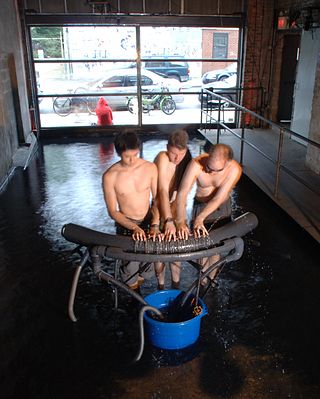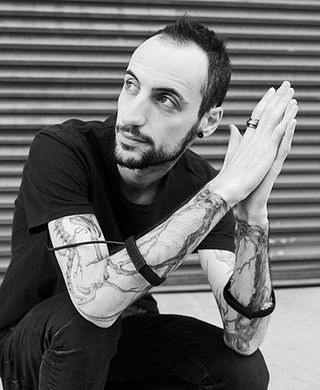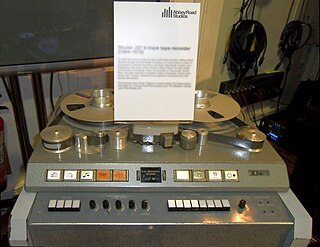Related Research Articles

An electronic musical instrument or electrophone is a musical instrument that produces sound using electronic circuitry. Such an instrument sounds by outputting an electrical, electronic or digital audio signal that ultimately is plugged into a power amplifier which drives a loudspeaker, creating the sound heard by the performer and listener.
Musique concrète is a type of music composition that utilizes recorded sounds as raw material. Sounds are often modified through the application of audio signal processing and tape music techniques, and may be assembled into a form of sound collage. It can feature sounds derived from recordings of musical instruments, the human voice, and the natural environment as well as those created using sound synthesis and computer-based digital signal processing. Compositions in this idiom are not restricted to the normal musical rules of melody, harmony, rhythm, and metre. The technique exploits acousmatic sound, such that sound identities can often be intentionally obscured or appear unconnected to their source cause.

Digital music technology encompasses the use of digital instruments, computers, electronic effects units, software, or digital audio equipment by a performer, composer, sound engineer, DJ, or record producer to produce, perform or record music. The term refers to electronic devices, instruments, computer hardware, and software used in performance, playback, recording, composition, mixing, analysis, and editing of music.

Pauline Oliveros was an American composer, accordionist and a central figure in the development of post-war experimental and electronic music.
Programming is a form of music production and performance using electronic devices and computer software, such as sequencers and workstations or hardware synthesizers, sampler and sequencers, to generate sounds of musical instruments. These musical sounds are created through the use of music coding languages. There are many music coding languages of varying complexity. Music programming is also frequently used in modern pop and rock music from various regions of the world, and sometimes in jazz and contemporary classical music. It gained popularity in the 1950s and has been emerging ever since.

Buchla Electronic Musical Instruments (BEMI) was a manufacturer of synthesizers and unique MIDI controllers. The origins of the company could be found in Buchla & Associates, created in 1963 by synthesizer pioneer Don Buchla of Berkeley, California. In 2012 the original company led by Don Buchla was acquired by a group of Australian investors trading as Audio Supermarket Pty. Ltd. The company was renamed Buchla Electronic Musical Instruments as part of the acquisition. In 2018 the assets of BEMI were acquired by a new entity, Buchla U.S.A., and the company continues under new ownership.

The Omnichord is an electronic musical instrument introduced in 1981 by the Suzuki Musical Instrument Corporation. It allows users to play distinctive harp-like arpeggios produced through an electronic strum plate, simulating the experience of playing a stringed instrument. Originally conceived as an electronic Autoharp, the Omnichord found popularity due to its portability, its unique timbre, and its value as a kitsch object.

New Interfaces for Musical Expression, also known as NIME, is an international conference dedicated to scientific research on the development of new technologies and their role in musical expression and artistic performance.

Tod Machover, is a composer and an innovator in the application of technology in music. He is the son of Wilma Machover, a pianist and Carl Machover, a computer scientist.
The College of Design at the Georgia Institute of Technology, established in 1908 as the Department of Architecture and also formerly called the College of Architecture, offered the first four-year course of study in architecture in the Southern United States.
Gil Weinberg is an Israeli-born American musician and inventor of experimental musical instruments and musical robots. Weinberg is a professor of musical technology at Georgia Tech and founding director of the Georgia Tech Center for Music Technology.
Sonic interaction design is the study and exploitation of sound as one of the principal channels conveying information, meaning, and aesthetic/emotional qualities in interactive contexts. Sonic interaction design is at the intersection of interaction design and sound and music computing. If interaction design is about designing objects people interact with, and such interactions are facilitated by computational means, in sonic interaction design, sound is mediating interaction either as a display of processes or as an input medium.

The Georgia Institute of Technology is a public research university and institute of technology in Atlanta, Georgia. Established in 1885, it is part of the University System of Georgia and has satellite campuses in Savannah, Georgia, Metz, France, Shenzhen, China, and Singapore.
Sound and music computing (SMC) is a research field that studies the whole sound and music communication chain from a multidisciplinary point of view. By combining scientific, technological and artistic methodologies it aims at understanding, modeling and generating sound and music through computational approaches.

David Nathaniel Kerzner is an American musician, songwriter, producer, and sound designer as well as founder of the sound sampling development company Sonic Reality Inc. Along with Simon Collins, Kerzner is the co-founder of the band Sound of Contact. He is also the co-founder of the band Mantra Vega. His debut solo album, New World, was released in December 2014.

MTF Labs is a series of festivals and events encouraging innovation through creative work, particularly music.

Marco Donnarumma is an Italian performance artist, new media artist and scholar based in Berlin. His work addresses the relationship between body, politics and technology. He is widely known for his performances fusing sound, computation and biotechnology. Ritual, shock and entrainment are key elements to his aesthetics. Donnarumma is often associated with cyborg and posthuman artists and is acknowledged for his contribution to human-machine interfacing through the unconventional use of muscle sound and biofeedback. From 2016 to 2018 he was a Research Fellow at Berlin University of the Arts in collaboration with the Neurorobotics Research Lab at Beuth University of Applied Sciences Berlin. In 2019, together with bioartist Margherita Pevere and media artist Andrea Familari, he co-founded the artists group for hybrid live art Fronte Vacuo.

In music production, the recording studio is often treated as a musical instrument when it plays a significant role in the composition of music. Sometimes called "playing the studio", the approach is typically embodied by artists or producers who favor the creative use of studio technology in record production, as opposed to simply documenting live performances in studio. Techniques include the incorporation of non-musical sounds, overdubbing, tape edits, sound synthesis, audio signal processing, and combining segmented performances (takes) into a unified whole.

Eric Singer is a multi-disciplinary artist, musician and software, electrical, computer, robotics, and medical device engineer. He is known for his interactive art and technology works, robotic and electronic musical instruments, fire art, and guerilla art.
References
- ↑ GTCMT Website
- ↑ Atlanta Business Chronicle
- ↑ Chronicle of Higher Education
- ↑ Tech Transfer News
- ↑ "Finding Our Way and Inventing Musical Instruments (Published 2013)". The New York Times .
- ↑ "Sonic Generator Website". Archived from the original on 2014-02-04. Retrieved 2014-01-20.
- ↑ Listening Machines